Ricoh SP 4510DN User Manual
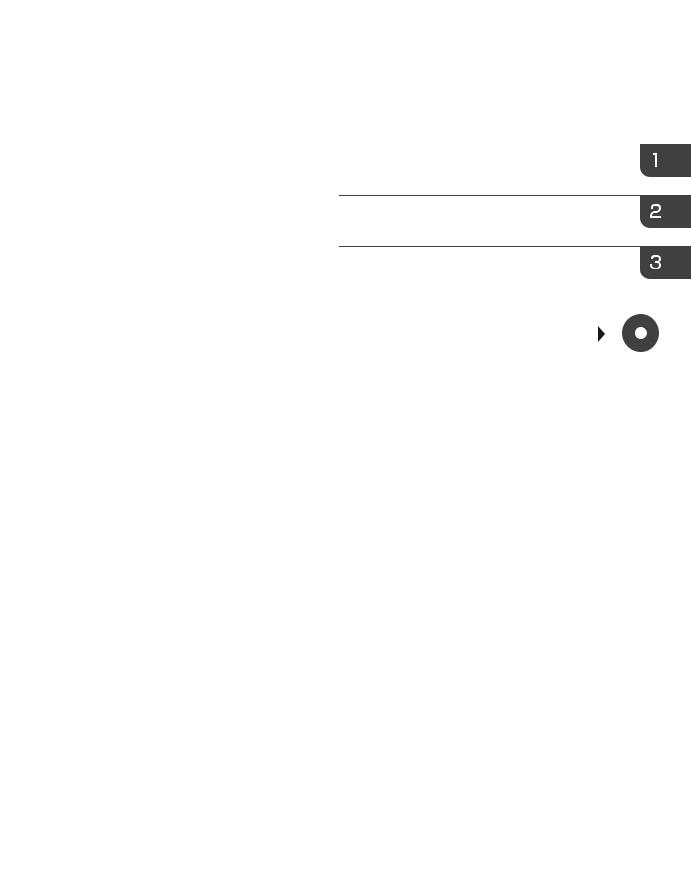
User Guide
Getting Started
Loading Paper
Troubleshooting
For information not in this manual, refer to the HTML/PDF files on the supplied
CD-ROM.
For safe and correct use, be sure to read the Safety Information in "Read This First" before using the machine.
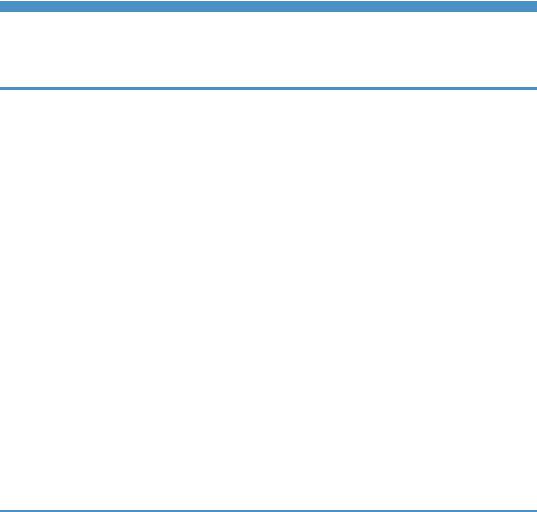
TABLE OF CONTENTS |
|
Manuals for This Machine................................................................................................................................. |
3 |
List of Manuals.................................................................................................................................................... |
5 |
1. Getting Started |
|
Before You Start.................................................................................................................................................. |
7 |
How to Read the Manuals............................................................................................................................. |
7 |
Model-Specific Information........................................................................................................................... |
8 |
List of Options................................................................................................................................................. |
9 |
Guide to Names and Functions of Components............................................................................................ |
11 |
Guide to Components................................................................................................................................. |
11 |
Guide to the Names and Functions of the Control Panel......................................................................... |
16 |
Guide to the Names and Functions of the Control Panel Screen............................................................ |
20 |
Turning On/Off the Power.............................................................................................................................. |
26 |
Turing On the Power.................................................................................................................................... |
26 |
Turning Off the Power.................................................................................................................................. |
26 |
Saving Energy.............................................................................................................................................. |
27 |
Displaying the Printer Configuration Screens Using the Control Panel........................................................ |
30 |
Configuring Printer Settings from the [Menu] key...................................................................................... |
30 |
Configuring Printer Settings from the [User Tools] key.............................................................................. |
30 |
Using Web Image Monitor............................................................................................................................. |
32 |
Displaying the top page.............................................................................................................................. |
33 |
2. Loading Paper |
|
Paper Loading Procedure................................................................................................................................ |
37 |
Paper Size Specifications................................................................................................................................ |
38 |
Paper Type Specifications............................................................................................................................... |
41 |
Paper Precautions............................................................................................................................................. |
43 |
Loading Paper into Paper Trays...................................................................................................................... |
45 |
When Loading Paper Larger than A4 or 81/2 × 11................................................................................ |
48 |
Loading Paper into the Bypass Tray............................................................................................................... |
50 |
Loading Orientation-Fixed Paper or Two-Sided Paper................................................................................ |
52 |
Loading Envelopes........................................................................................................................................... |
54 |
Specifications of Envelopes......................................................................................................................... |
55 |
Printing on Envelopes with Windows (PCL 6/PostScript 3)..................................................................... |
57 |
Printing on Envelopes with Windows (PCL 5e/5c)................................................................................... |
57 |
1
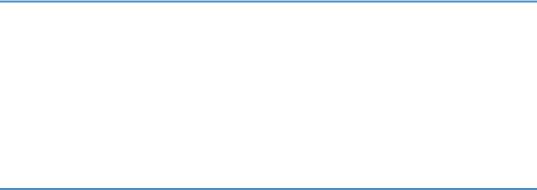
Printing on Envelopes with Mac OS X........................................................................................................ |
58 |
Paper Settings................................................................................................................................................... |
60 |
Specifying a Paper Size.............................................................................................................................. |
60 |
Specifying a Paper Type............................................................................................................................. |
61 |
Configuring Envelope Settings Using the Control Panel........................................................................... |
62 |
3. Troubleshooting |
|
When a Panel Tone Beeps.............................................................................................................................. |
65 |
When Checking the Indicator Lamps, Status Icons, and Messages on the Control Panel......................... |
66 |
Indicators...................................................................................................................................................... |
66 |
Checking Printer Status and Settings.......................................................................................................... |
66 |
When the Indicator Lamp for the [Check Status] Key Is Lit or Flashing................................................... |
67 |
If USB Connection Fails................................................................................................................................... |
70 |
When Messages Are Displayed..................................................................................................................... |
71 |
Status Messages.......................................................................................................................................... |
71 |
Alert Messages (Displayed on the Control Panel).................................................................................... |
72 |
Alert Messages (Printed on Error Logs and Reports)................................................................................ |
83 |
When You Cannot Print................................................................................................................................... |
98 |
When the Data In Indicator Does Not Light Up or Flash....................................................................... |
101 |
Other Printing Problems................................................................................................................................. |
102 |
When You Cannot Print Properly............................................................................................................. |
102 |
Paper Misfeeds Occur Frequently........................................................................................................... |
107 |
Additional Troubleshooting...................................................................................................................... |
111 |
The Printed Image is Different from the Image on the Computer........................................................... |
115 |
When Printer Is Not Functioning Properly............................................................................................... |
116 |
Removing Jammed Paper.............................................................................................................................. |
119 |
Paper Misfeed Message (A1).................................................................................................................. |
119 |
Paper Misfeed Message (A2).................................................................................................................. |
121 |
Paper Misfeed Message (B)..................................................................................................................... |
122 |
Paper Misfeed Message (B) (C).............................................................................................................. |
125 |
Paper Misfeed Message (Y1) or (Y2)..................................................................................................... |
130 |
Paper Misfeed Message (Z1).................................................................................................................. |
132 |
Paper Misfeed Message (Z2).................................................................................................................. |
134 |
Trademarks..................................................................................................................................................... |
137 |
2

Manuals for This Machine
Read this manual carefully before using this machine.
Refer to the manuals that are relevant to what you want to do with the machine.
•The method for viewing the manual depends on the manual.
•Adobe® Acrobat® Reader®/Adobe Reader must be installed in order to view the manuals as PDF files.
•A Web browser must be installed in order to view the HTML manuals.
User Guide
Summaries are provided below for the operating instructions regarding the basic usage of this machine, frequently used functions, and troubleshooting when an error message appears.
Read This First
Before using the machine, be sure to read the "Safety Information" section of this manual. It describes the regulations and environmental conformance.
Quick Installation Guide
Describes procedures from unpacking the machine to connecting it to a computer.
Operating Instructions
Provides detailed information about the operation of the machine in HTML format. The following are the main topics of the manual:
•Getting Started
•Setting Up the Printer
•Loading Paper
•Printing
•Configuring and Managing the Printer
•Troubleshooting
•Maintenance and Specifications
•VM Card Extended Feature Settings
Security Guide
This manual is for administrators of the machine. It explains security functions that you can use to prevent unauthorized use of the machine, data tampering, or information leakage. For enhanced security, we recommend that you first:
•Install the Device Certificate.
•Enable SSL (Secure Sockets Layer) Encryption.
•Change the user name and password of the administrator using Web Image Monitor.
3

For details, see "Before Using This Printer", Security Guide.
Be sure to read this manual when configuring the enhanced security functions or user and administrator authentication.
Driver Installation Guide
Explains how to install and configure the drivers.
4

List of Manuals
|
|
Manual Name |
Printed Manual |
PDF Manual |
HTML Manual |
|
|
Provided |
Provided |
Provided |
|
|
|
|
|||
|
|
|
|
|
|
User Guide |
No |
Yes |
No |
||
|
|
|
|
|
|
Read This First |
Yes |
No |
No |
||
|
|
|
|
|
|
Quick Installation Guide |
Yes |
No |
No |
||
|
|
|
|
|
|
Operating Instructions |
No |
No |
Yes |
||
|
|
|
|
|
|
Security Guide |
No |
Yes |
No |
||
|
|
|
|
|
|
Driver Installation Guide |
No |
Yes |
No |
||
|
|
|
|
|
|
|
|
|
|
|
|
|
|
|
|
|
|
•Operating Instructions and Driver Installation Guide are available in English, German, French, Italian, Spanish, Dutch, and Russian.
5

6

1. Getting Started
This section describes the symbols used in the manuals supplied with the printer, available options, and names and functions of components.
Before You Start
How to Read the Manuals
Symbols used in the manuals
This manual uses the following symbols:
Indicates points to pay attention to when using the machine, and explanations of likely causes of paper misfeeds, damage to originals, or loss of data. Be sure to read these explanations.
Indicates supplementary explanations of the machine's functions, and instructions on resolving user errors.
This symbol is located at the end of sections. It indicates where you can find further relevant information.
[ ]
Indicates the names of keys on the machine's display or control panels.
Indicates the key sequence order you should perform using the control panel. Example:
Select [Host Interface]  Press [OK]
Press [OK]
(Select [Host Interface], and then press the [OK] key.) 



 (mainly Europe and Asia)
(mainly Europe and Asia)




 (mainly North America)
(mainly North America)
Differences in the functions of Region A and Region B models are indicated by the two symbols. Read the information indicated by the symbol that corresponds to the region of the model you are using. For details about which symbol corresponds to the model you are using, see page 8 "Model-Specific Information".
7
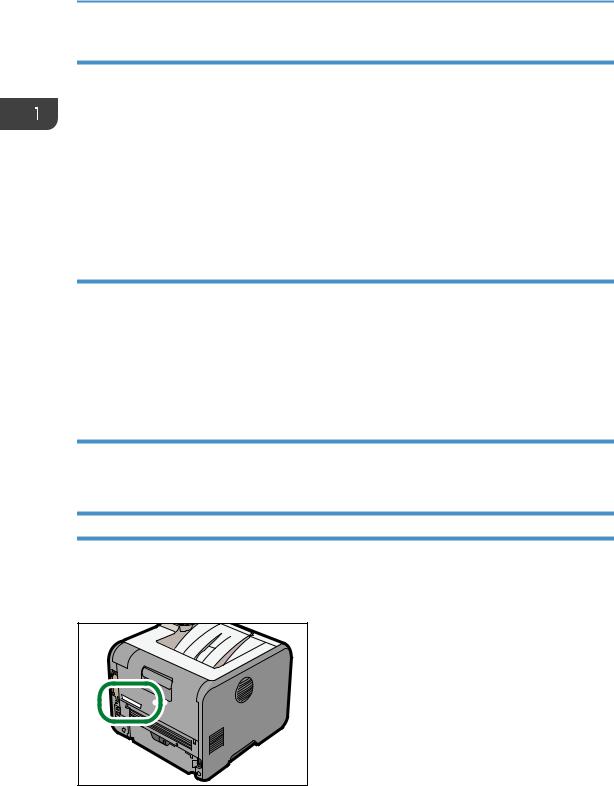
1. Getting Started
Disclaimer
Contents of this manual are subject to change without prior notice.
To the maximum extent permitted by applicable laws, in no event will the manufacturer be liable for any damages whatsoever arising out of failures of this machine, losses of the registered data, or the use or non-use of this product and operation manuals provided with it.
Make sure that you always copy or have backups of the data registered in this machine. Documents or data might be erased due to your operational errors or malfunctions of the machine.
In no event will the manufacturer be responsible for any documents created by you using this machine or any results from the data executed by you.
Notes
The manufacturer shall not be responsible for any damage or expense that might result from the use of parts other than genuine parts from the manufacturer with your office products.
For good output quality, the manufacturer recommends that you use genuine toner from the manufacturer.
Some illustrations in this manual might be slightly different from the machine.
About IP addresses
In this manual, "IP address" covers both IPv4 and IPv6 environments. Read the instructions that are relevant to the environment you are using.
Model-Specific Information
This section explains how to identify the region to which your printer belongs.
There is a label on the rear of the printer, located in the position shown below. The label contains details that identify the region to which your printer belongs. Read the label.
CYN090 |
8
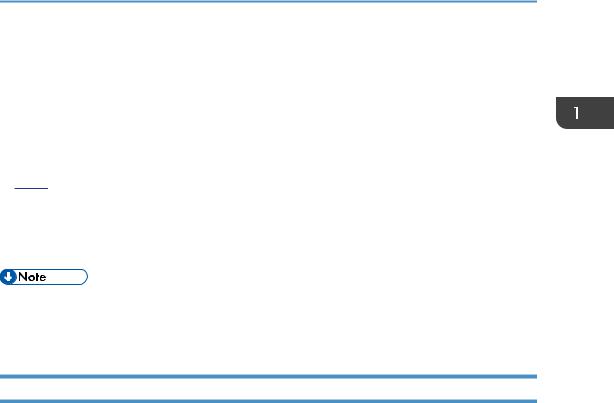
Before You Start
The following information is region-specific. Read the information under the symbol that corresponds to the region of your printer.




 (mainly Europe and Asia)
(mainly Europe and Asia)
If the label contains the following, your printer is a Region A model:
•CODE XXXX -27
•220–240 V




 (mainly North America)
(mainly North America)
If the label contains the following, your printer is a Region B model:
•CODE XXXX -17
•120–127 V
•Dimensions in this manual are given in two measurement units: metric and imperial. If your printer is a Region A model, refer to the metric units. If your printer is a Region B model, refer to the imperial units.
List of Options
This section provides a list of options for this printer and the names commonly used in this manual.
Option name |
Description |
|
|
Paper Feed Unit PB1060 |
250-sheet paper feed unit |
|
|
Paper Feed Unit PB1070 |
500-sheet paper feed unit |
|
|
Memory Unit Type N1 1.0GB |
SDRAM module |
|
|
Hard Disk Drive Option Type P1 |
Hard disk |
|
|
IEEE802.11 Interface Unit Type O |
Wireless LAN interface board |
|
|
IEEE 1284 Interface Board Type A |
IEEE 1284 interface board |
|
|
SD card for NetWare printing Type P1 |
NetWare card |
|
|
Browser Unit Type P1 |
Browser unit |
|
|
XPS Direct Print Option Type P1 |
XPS card |
|
|
VM CARD Type W |
VM card |
|
|
9

1.Getting Started
•The browser unit is available for SP 4520DN only.
10
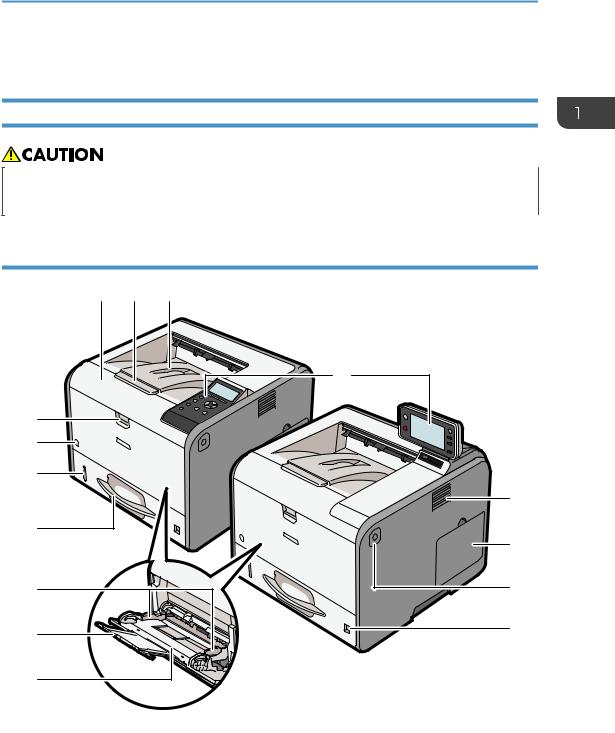
Guide to Names and Functions of Components
Guide to Names and Functions of Components
Guide to Components
•Do not obstruct the machine's vents. Doing so risks fire caused by overheated internal components.
Exterior: Front view
1 2 3
|
4 |
15 |
|
14 |
|
13 |
|
|
5 |
12 |
|
|
6 |
11 |
7 |
10 |
8 |
|
9
CYN001
1.Front cover
Open to access the inside of the printer and remove jammed paper. Open here to replace the print cartridge and the drum unit.
11
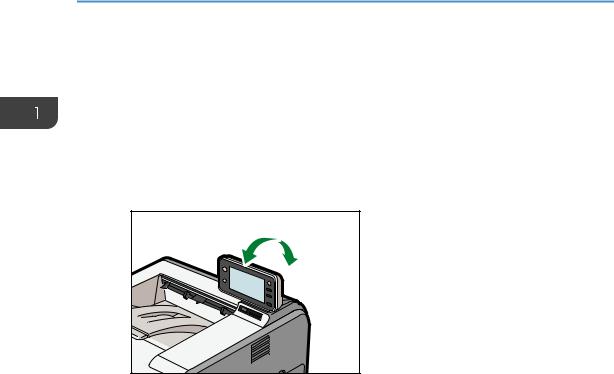
1.Getting Started
2.Tray Extension
Pull this fence to prevent paper from falling off.
3.Standard tray
Output is stacked here with the print side down.
4.Control panel
For details, see page 16 "Guide to the Names and Functions of the Control Panel".
•For SP 4520DN
You can adjust the display with your hands. Adjust the angle of it to see clearly.
CYN089
5.Ventilation holes
Prevent overheating.
6.Memory cover
Remove this cover to install the optional SDRAM module and hard disk.
7.Front cover open button
Push this button to open the front cover.
8.Paper size dial
Use this dial to specify the paper size. To use a paper size that is not indicated on the paper size dial, set the dial to " ". If this is the case, set the paper size using the control panel.
". If this is the case, set the paper size using the control panel.
9.Bypass tray
Up to 100 sheets of plain paper can be loaded.
For details about the sizes and types of paper that can be used, see page 38 "Paper Size Specifications" and page 41 "Paper Type Specifications".
10.Extender for the bypass tray
Pull this extender out when loading A4 , 81/2 × 11
, 81/2 × 11 or larger size paper in the bypass tray.
or larger size paper in the bypass tray.
11.Paper guides
When loading paper in the bypass tray, align the paper guides flush against the paper.
12.Tray 1
Up to 500 sheets of plain paper can be loaded.
12
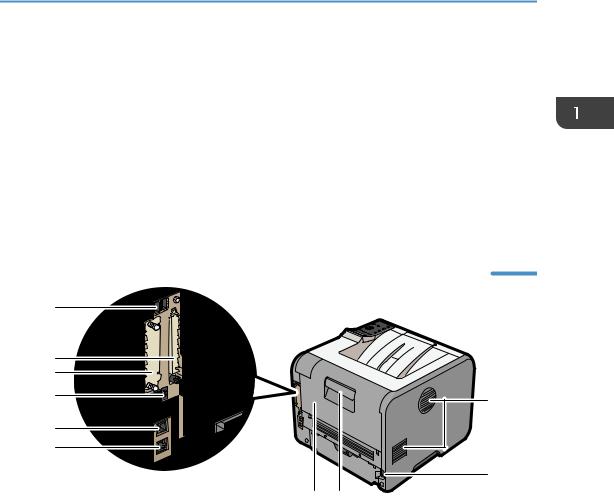
Guide to Names and Functions of Components
For details about the sizes and types of paper that can be used, see page 38 "Paper Size Specifications" and page 41 "Paper Type Specifications".
13.Remaining paper indicator
Indicates the approximate amount of paper remaining in the tray.
14.Main power switch
Use this switch to turn the power on and off.
For details about how to shut down the printer, see page 26 "Turning Off the Power".
15.Bypass tray open lever
Push this lever to open the bypass tray.
Exterior: Rear view
10
9
8
7 |
1 |
|
6
5
2
4 3
CYN003
1.Ventilation holes
Prevent overheating.
2.Power connector
Connect the power cord to the printer. Insert the other end into an electrical outlet.
3.Rear cover open lever
Pull this lever to open the rear cover.
4.Rear cover
Open to access the inside of the printer.
Open here to replace the fusing unit or using the envelope lever.
5.Ethernet port
Use a network interface cable to connect the printer to a network.
6.USB port B
Use a USB cable to connect the printer to a computer.
13

1.Getting Started
7.USB port H (Port for use by customer engineer)
Do not use this port.
8.Optional interface board slot
Optional interface boards can be inserted.
Insert an optional wireless LAN interface board or IEEE 1284 interface board.
9.Expansion card slots
Remove the cover to install SD cards.
10.USB port A
Connect external devices such as a card authentication device, etc.
Interior: Front view
1
2
CYN002
1.Print cartridge
Messages appear on the screen when the print cartridge needs to be replaced, or a new cartridge needs to be prepared.
For details about the messages that appear on the screen when consumables need to be replaced, see "Replenishing and Replacing Consumables", Operating Instructions.
•When you set the print cartridge apart from the drum unit, pull down the lever on the right side of the print cartridge, and then pull the print cartridge out.
2.Drum unit
Messages appear on the screen when the drum unit needs to be replaced, or a new drum unit needs to be prepared.
For details about the messages that appear on the screen when consumables need to be replaced, see "Replenishing and Replacing Consumables", Operating Instructions.
14
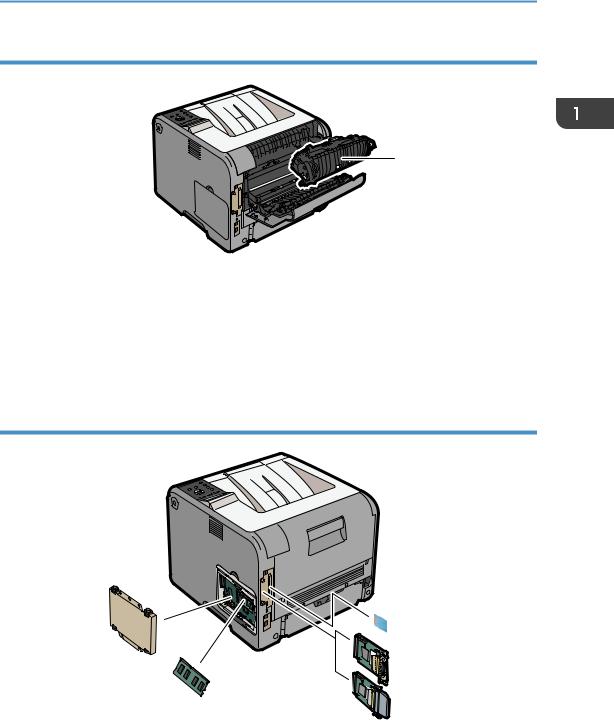
Guide to Names and Functions of Components
Interior: Rear view
1
CYN004
1.Fusing unit
Messages appear on the screen when the fusing unit needs to be replaced, or a new fusing unit needs to be prepared.
For details about the messages that appear on the screen when consumables need to be replaced, see "Replenishing and Replacing Consumables", Operating Instructions.
The fusing unit is included in Maintenance Kit.
Guide to functions of the printer's internal options
 1
1
4
3 |
2 |
|
CYN088
1.SD memory card options
•VM card
With this card, you can install embedded software applications.
•NetWare card
15
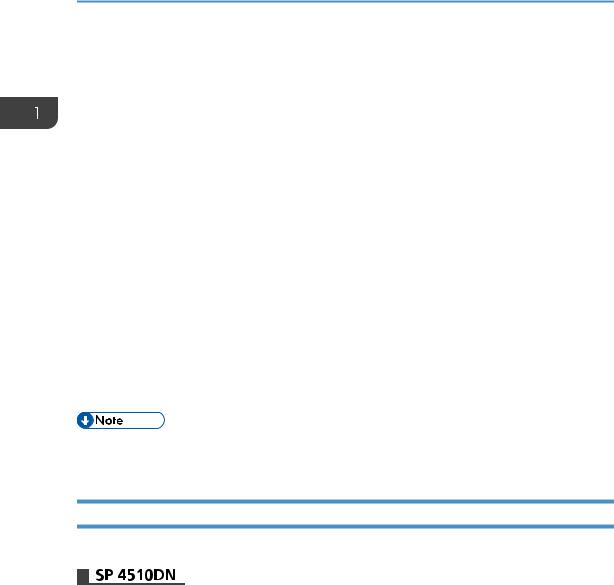
1. Getting Started
This card is needed when using a NetWare server.
•XPS card
Allows you to print XPS files.
•Browser unit (for SP 4520DN)
Allows you to display Web pages on the screen of the control panel and print them.
To attach this option, "Installing SD Card Options", Operating Instructions.
2.Optional interface units
•Wireless LAN board
Allows you to communicate over a wireless LAN.
•IEEE 1284 interface board
Allows you to connect to an IEEE 1284 cable.
To attach this option, see "Installing the Interface Units", Operating Instructions.
3.SDRAM module
You can add the SDRAM up to 1.0 GB.
To attach this option, see "Installing the SDRAM module", Operating Instructions.
4.Hard disk
Allows you to store documents to be printed.
To attach this option, see "Installing the hard disk", Operating Instructions.
•If you want to use two or more SD cards that can be inserted in the same slot, contact your sales or service representative.
Guide to the Names and Functions of the Control Panel
This illustration shows the control panel of the printer.
16
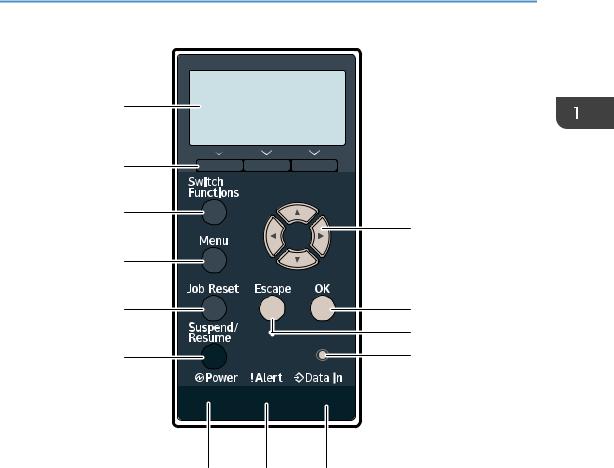
Guide to Names and Functions of Components
1 |
|
2 |
|
3 |
|
|
13 |
4 |
|
5 |
12 |
|
11 |
6 |
10 |
7 |
8 |
9 |
|
|
CYN041 |
1.Display
Displays current printer status and error messages.
Entering energy saver mode turns off the back light. For details about energy saver mode, see page 27 "Saving Energy".
2.Selection keys
Correspond to the function items at the bottom line on the display.
Example: When this manual instructs you to press [Option], press the selection key on the left below the initial screen.
3.[Switch Functions] key
Press this key to switch between the operation screen of the printer function and the function screens of the extended features currently in use.
4.[Menu] key
Press this key to configure and check the current printer settings.
Press to change the default settings to meet your requirements. See page 30 "Configuring Printer Settings from the [Menu] key".
17

1.Getting Started
5.[Job Reset] key
Press to cancel the current print job.
6.[Suspend/Resume] key
Press this to suspend the print job currently being processed. The indicator remains lit as long as the job is suspended.
To resume the job, press this key again. The suspended job will resume automatically when the time specified in [Auto Reset Timer] elapses (default: 60 seconds).
For details about the [Auto Reset Timer] setting, see "Timer Settings", Operating Instructions.
7.Power indicator
Lights up when the printer is ready to receive data from a computer. Flashes when the printer is warming up or receiving data. It is unlit when the power is off or while the printer is in energy saver mode.
8.Alert indicator
Lights up or flashes when a printer error occurs.
Steady red: printing is not possible, or is possible but print quality cannot be ensured.
Flashing yellow: the printer will soon require maintenance or a replacement consumable such as print cartridge.
Follow the instructions that appear on the display.
9.Data in indicator
Flashes when the printer is receiving data from a computer. The data in indicator is lit if there is data to be printed.
10.Light sensor
The sensor that detects the ambient light level when the ECO Night Sensor function is enabled.
11.[Escape] key
Press this key to cancel an operation or return to the previous display.
12.[OK] key
Use this key to confirm settings or setting values, or move to the next menu level.
13.Scroll keys
Press these keys to move the cursor in each direction.
When the [ ] [
] [ ] [
] [ ] [
] [ ] keys appear in this manual, press the applicable key for the direction that you want to move the cursor.
] keys appear in this manual, press the applicable key for the direction that you want to move the cursor.
18
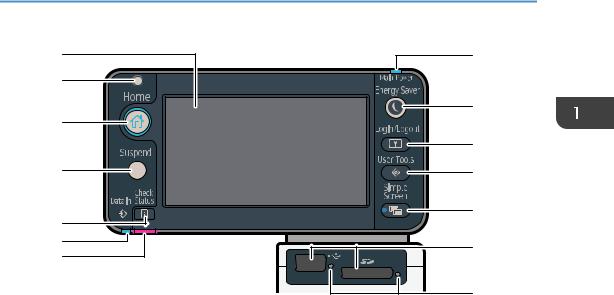
Guide to Names and Functions of Components
1 |
8 |
2 |
|
|
9 |
3 |
|
|
10 |
4 |
11 |
5 |
12 |
|
|
6 |
13 |
7 |
|
|
14 |
|
CYN040 |
1.Display panel
Displays function keys, operation status, and messages. See page 20 "Guide to the Names and Functions of the Control Panel Screen".
2.Light Sensor
Indicates that the sensor that detects the ambient light level when the ECO Night Sensor function is enabled.
3.[Home] key
Press to display the [Home] screen. For details, see page 22 "Using the [Home] screen".
4.[Suspend] key
Press this key to suspend a print job. The key lights up while the job is suspended.
5.[Check Status] key
Press to check the printer's system status, operational status of each function, and current jobs. You can also display the job history and the printer's maintenance information.
6.Data In indicator
Flashes when the printer is receiving print jobs from a computer. The indicator lights up when there is data to be printed.
7.Check Status indicator
Lights up or flashes when a printer error occurs. Steady red: Printing is not possible.
Flashing yellow: The printer will soon require maintenance or a replacement consumable such as a print cartridge. Printing is possible, but print quality cannot be ensured.
Follow the instructions that appear on the display.
8.Power indicator
Remains lit while the power is on. It is not lit when the power is off or when the printer is in energy saver mode.
19
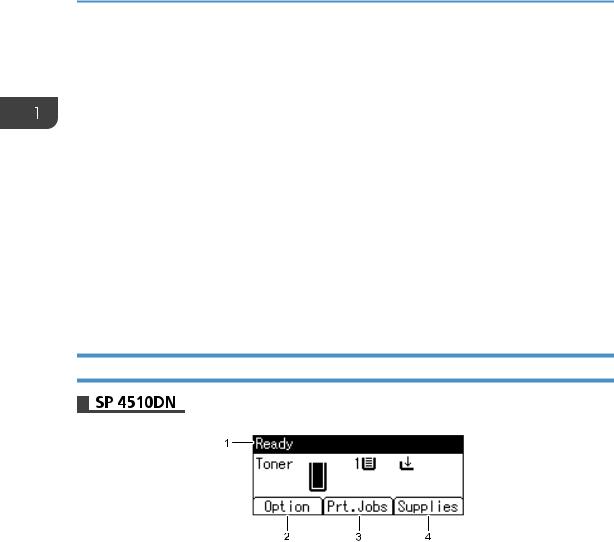
1.Getting Started
9.[Energy Saver] key
Press to switch to and from Sleep mode. See page 27 "Saving Energy". When the printer is in Sleep mode, the [Energy Saver] key flashes slowly.
10.[Login/Logout] key
Press to log in or log out.
11.[User Tools] key
Press to change the default settings as needed. See page 30 "Configuring Printer Settings from the [User Tools] key".
12.[Simple Screen] key
Press to switch to the simple screen. See "Switching screen patterns", Operating Instructions.
13.Media slots
Insert an SD card or a USB flash memory device.
14.Media access lamp
Lights up when a memory storage device is inserted in the media slot or is being accessed.
Guide to the Names and Functions of the Control Panel Screen
CYN901
1.Operational Status or Messages
Displays the printer status and messages.
2.[Option]
Press to display the following items:
•Form Feed
•Error Log
3.[Prt.Jobs]
Press to display print jobs sent from a computer.
[Prt.Jobs] is displayed only when the optional hard disk is installed in the printer.
4.[Supplies]
Press to display the information about printer supplies.
20
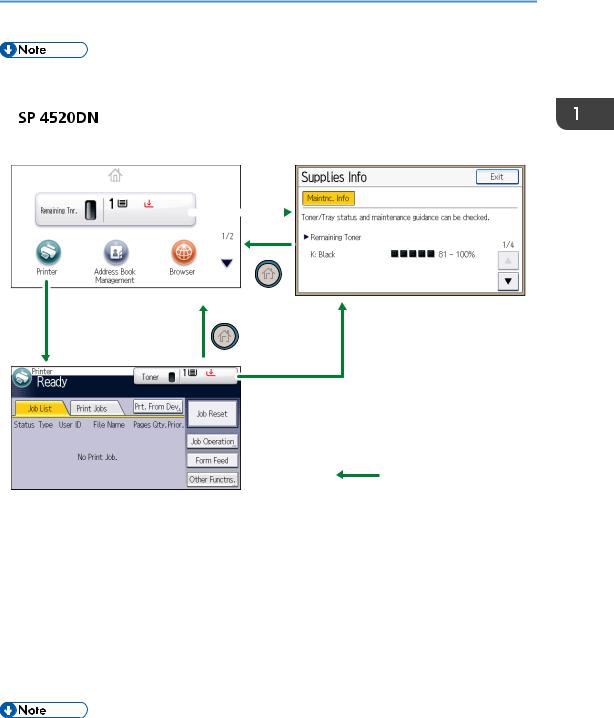
Guide to Names and Functions of Components
•By default, the remaining amount of toner is displayed. To avoid displaying the remaining amount of toner, set [Display Supply Info] to [Off] in [General Settings] under [Maintenance].
|
|
|
|
|
1 |
3 |
|||
|
|
|
|
|
2
 Touch the display panel
Touch the display panel
Press the [Home] key
CYN902
1.[Home] screen
Displays function and shortcut icons. For details, see page 22 "Using the [Home] screen".
The [Home] screen is set as the default screen when the printer is turned on. You can change this default setting under Function Priority. See "System Settings", Operating Instructions.
2.[Printer] screen
Displays operation status, messages, and function menus. For details, see page 23 "Using the [Printer] screen".
3.[Supplies Info] screen
Checks the printer status, such as toner and paper levels.
•After finishing a job, the printer waits a specified length of time, then restores its settings to the default values specified under Function Priority. This function is called "System Reset". For the procedure for specifying default settings under Function Priority, see "System Settings", Operating Instructions.
21
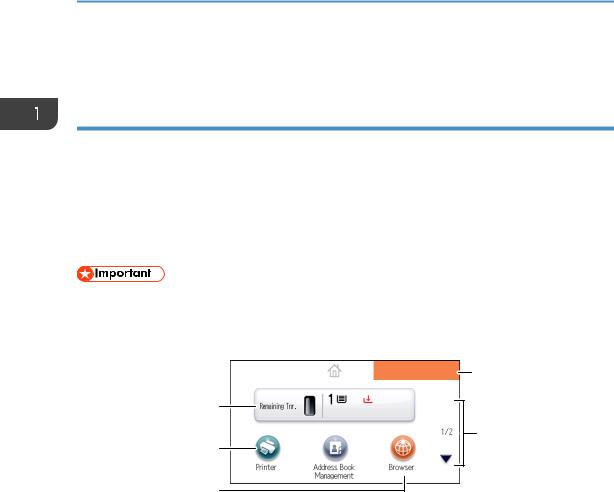
1. Getting Started
•To change the length of time that the printer waits before restoring its settings to their default values, use the Printer Auto Reset Timer setting. See "System Settings", Operating Instructions.
Using the [Home] screen
This function is available for SP 4520DN only.
To display the [Home] screen, press the [Home] key.
Each function has its own icon, and these icons are displayed on the [Home] screen.
You can add shortcuts to frequently used embedded software applications to the [Home] screen. The icons of added shortcuts appear on the [Home] screen. The embedded software applications can be called easily by pressing the shortcut icons.
•Do not apply strong impact or force to the screen. Doing so will damage the screen. Maximum force allowable is approx. 30 N (approx. 3 kgf). (N = Newton, kgf = Kilogram force. 1 kgf = 9.8 N.)
4
1
5
2
3
CYN903
1.Supply Information icon
Press to display the [Supplies Info] screen to check toner and paper levels.
2.[Printer]
Press to display the [Printer] screen.
3.Shortcut icon area
You can add shortcuts to embedded software applications to the [Home] screen. For details about registering shortcuts, see "Adding icons to the [Home] screen", Operating Instructions.
4.Home screen image
You can display an image such as a corporate logo on the [Home] screen. To change the image, see "Displaying the image on the [Home] screen", Operating Instructions.
5. /
/
Press to switch pages when icons are not displayed on one page.
22
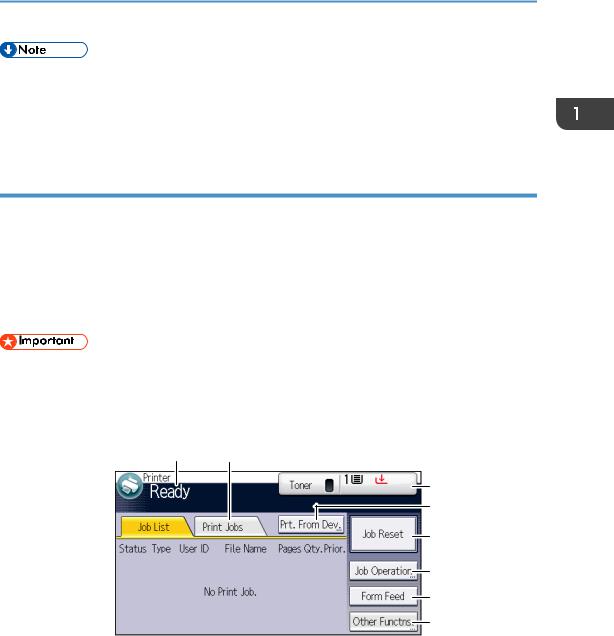
Guide to Names and Functions of Components
•When a software application to be embedded is installed, the function icon for the application is displayed on the [Home] screen.
•You can change the order of the icons. For details, see "Changing the order of icons on the [Home] screen", Operating Instructions.
Using the [Printer] screen
This function is available for SP 4520DN only.
The display panel shows the operation status, messages, and function menus.
The function items displayed serve as selector keys. You can select or specify an item by lightly pressing these keys.
When you select or specify an item on the display panel, it is highlighted such as  . Keys appearing as
. Keys appearing as  cannot be used.
cannot be used.
•Do not apply strong impact or force to the screen. Doing so will damage the screen. Maximum force allowable is approx. 30N (approx. 3 kgf). (N = Newton, kgf = Kilogram force. 1 kgf = 9.8N.)
The [Home] screen is set as the default screen when the printer is turned on.
1 2
3
4
5
6
7
8
CYN904
1.Operational status or messages
Displays the current printer status, such as "Ready", "Offline", and "Printing...". Information (user ID and document name) about the print job appears in this section.
2.[Print Jobs]
Press to display print jobs sent from a computer.
3.Supply Information
You can check the remaining toner and paper. Press to display the [Supplies Info] screen.
23
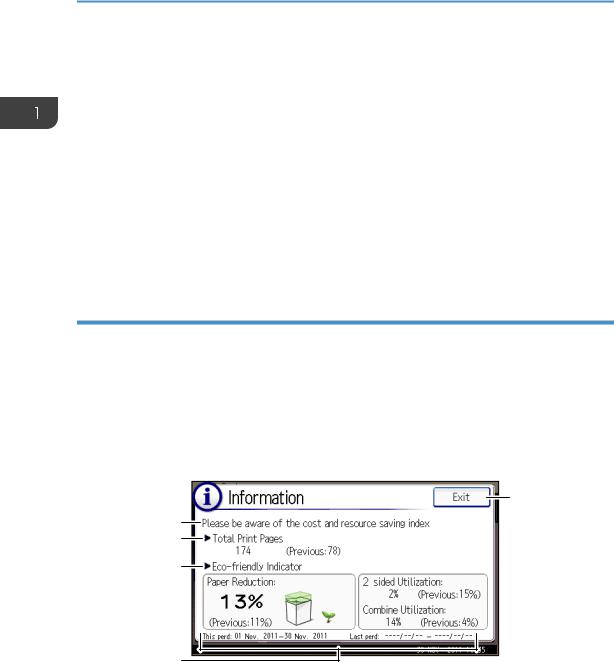
1.Getting Started
4.[Prt. From Dev.]
Press to display the screen for directly printing files stored on memory storage devices.
5.[Job Reset]
Press to cancel the current print job.
If you press it when Hex Dump is selected, Hex Dump is canceled.
6.[Job Operation]
Press to suspend a job being processed.
7.[Form Feed]
Press to print all the data left in the printer's input buffer.
8.[Other Functns.]
Press to display the error logs and status of spooled jobs.
Using the [Information] screen
This function is available for SP 4520DN only.
To raise environmental awareness, you can configure the printer to show users the amount of paper saved by using the various paper saving functions of the printer.
When user authentication is enabled, the screen is displayed when you log in to the printer. When user authentication is not enabled, the screen is displayed after the printer returns from Sleep mode or after a system reset. The [Information] screen appears when the power is turned on, regardless of the authentication settings.
5
1
2
3
4
CQT201
1.Message
Displays messages from the administrator.
2.Total Print Pages
Displays the total numbers of pages printed in the current and previous count periods.
3.Eco-friendly Indicator
•Paper Reduction:
24
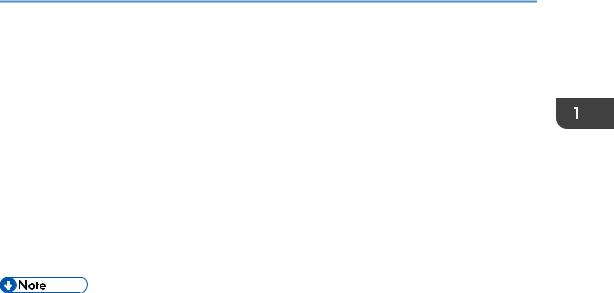
Guide to Names and Functions of Components
Shows the amount of paper saved by using the duplex and combine printing functions. The value indicates the percentage of paper saved from the total of all the paper used. As the percentage increases, the stack of paper decreases and the flower grows. When the ratio is 76% or more, the flower starts to bloom.
•2 sided Utilization:
Displays the ratio of 2-sided prints to the total number of prints.
•Combine Utilization:
Displays the ratio of combined prints to the total number of prints.
4.Count periods
Displays the current and previous count periods.
5.[Exit]
Press this to close the [Information] screen and return to operation.
•Depending on the printer settings, the [Information] screen may not be displayed. For details, see Security Guide.
•You can also use Web Image Monitor to check the usage status. For further details, see Web Image Monitor Help.
•Under [Eco-friendly Counter Period/Administrator Message] in [System Settings], you can check "Count Period", "Administrator Message", "Display Information Screen", and "Display Time". Only the administrator can change the settings. For details, see Security Guide.
25
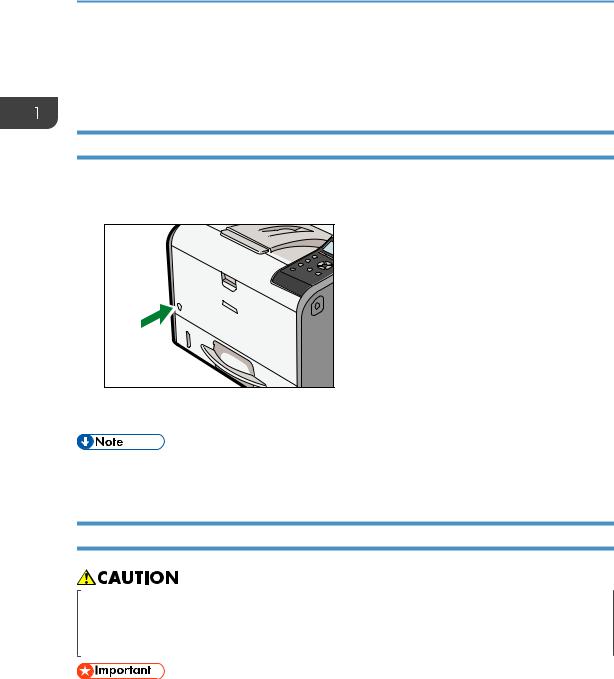
1. Getting Started
Turning On/Off the Power
This section explains how to turn on/off the printer.
Turing On the Power
1.Make sure the power cord is firmly plugged into the wall outlet.
2.Push the main power switch.
CYN031 |
The power indicator turns on.
•After you switch the main power on, a screen may appear to indicate that the printer is initializing. Do not switch the power off during this process. Initialization takes about three minutes.
Turning Off the Power
•When disconnecting the power cord from the wall outlet, always pull the plug, not the cord. Pulling the cord can damage the power cord. Use of damaged power cords could result in fire or electric shock.
•Do not press and hold the main power switch when turning off the printer. Doing so shuts down the printer forcefully and may damage the hard disk and the SDRAM module, causing a malfunction of the printer.
•Before unplugging the power cord plug, turn off the power switch and make sure the power switch indicator turns off. Not doing so may result in damage to the hard disk or memory, leading to a malfunction.
26
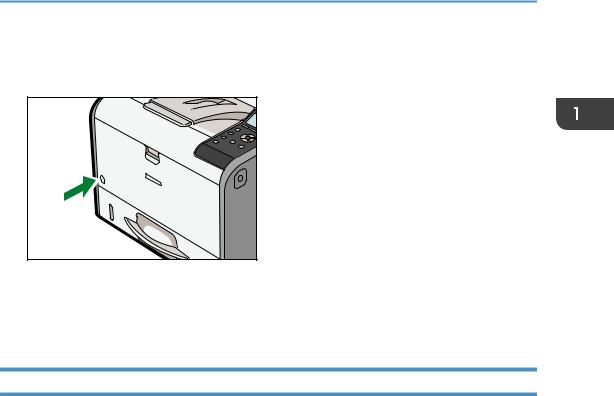
Turning On/Off the Power
• Do not turn off the power while the printer is in operation.
1. Push the main power switch.
CYN031 |
The main power is turned off automatically when the shutdown process is complete.
If the shutdown process is not complete within the period of time displayed on the screen, contact your service representative.
Saving Energy
This printer has the following energy saving functions:
Fusing Unit Off Mode
If you do not use the printer for a certain period after an operation, the display will turn off and the printer goes into Fusing Unit Off mode. The printer uses less electricity in Fusing Unit Off mode.
When the printer is in Fusing Unit Off mode, the display is on but the fusing unit heater is off to save energy. In this mode, you can change the printer settings on the control panel. However, the printer must exit this mode to print.
You can change the amount of time that the printer waits before switching to Fusing Unit Off mode under [Fusing Unit Off Mode Timer]. For details, see:
•"System", Operating Instructions. (for SP 4510DN)
•"Timer Settings", Operating Instructions. (for SP 4520DN) To exit Fusing Unit Off mode, do one of the following:
•Start print jobs
•Display the [Maintenance] screen on the control panel (for SP 4510DN)
•Display the [Maintenance: Print] or [Maintenance: Image] screen on the control panel (for SP 4520DN)
•Operate the control panel when [Exit Fusing Unit Off Mode] is set to [On Operating Control Panel]
•Start print jobs
27

1. Getting Started
Sleep mode
If the printer remains inactive for a specified period after entering Fusing Unit Off mode, it enters Sleep mode to further reduce the power consumption. The printer also enters Sleep mode when:
•The printer waits before entering Sleep mode is set in [Sleep Mode Timer]
•It is the day and time specified in [Weekly Timer]
When the printer is in Sleep mode, only the [Energy Saver] key and the [Check Status] key are usable. (for SP 4520DN)
The printer can print jobs from computers.
You can change the amount of time that the printer waits before switching to Sleep mode. For details about setting [Sleep Mode Timer] and [Weekly Timer], see:
•"System", Operating Instructions. (for SP 4510DN)
•"Timer Settings", Operating Instructions. (for SP 4520DN) To exit Sleep mode, do one of the following:
•Press one of the keys on the control panel (for SP 4510DN)
•Press the [Energy Saver] key or [Check Status] key (for SP 4520DN)
•Start print jobs
ECO Night Sensor
ECO Night Sensor can detect darkness and automatically turn off this product's power.
If ECO Night Sensor is enabled and detects darkness in a room after the lights are turned off, the sensor automatically turns the power off and reduces the power consumption of this product to 1W or less.
The default settings of ECO Night Sensor are enabled. To change the settings, see:
•"System", Operating Instructions. (for SP 4510DN)
•"Administrator Tools", Operating Instructions. (for SP 4520DN)
•The ECO Night Sensor function's factory default is [Auto Power Off Only]. If the printer is located in an environment where the ambient light level is low (such as in a hallway or a location with motion sensor lighting), it is advisable that you either keep this function disabled or adjust its sensitivity.
•You can configure the printer to automatically turn its power on when it detects an increase in the ambient light level. The printer may also react to daylight and turn its power on. If the printer is located in an environment where it is exposed to direct sunlight, it is advisable that you do not change the factory default configuration and only enable [Auto Power Off Only].
28
